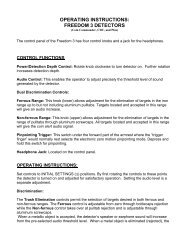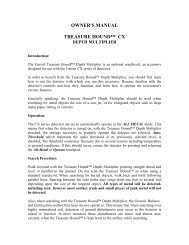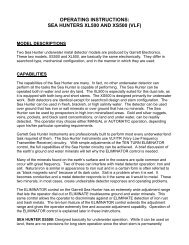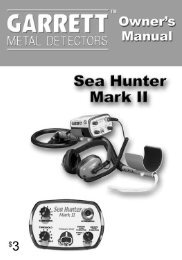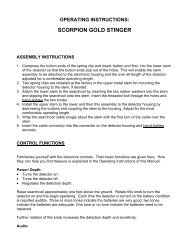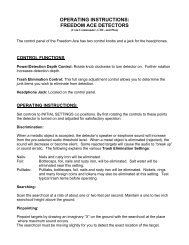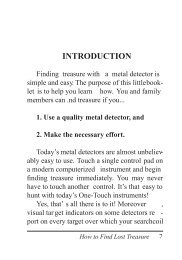Freedom 1 Detectors - Garrett
Freedom 1 Detectors - Garrett
Freedom 1 Detectors - Garrett
Create successful ePaper yourself
Turn your PDF publications into a flip-book with our unique Google optimized e-Paper software.
The batteries are located on the side of the chassis of <strong>Freedom</strong> 1 inside the control housing.To reach them disconnect the searchcoil cable and loosen the captive thumbscrew beneaththe control housing. Press on the searchcoil connector to loosen the chassis and carefully slideit out. The batteries are beneath a protective clamp directly behind the control panel. Loosenthe screw holding it and slide the clamp off to allow removal of the batteries.MAINTENANCE Always remember that your detector is a sensitive electronic instrument. It is built towithstand rugged treatment in the outdoors. Use your <strong>Garrett</strong> detector to the fullest extentpossible, and never feel that you have to baby it. Yet, always protect the detector andhandle it with reasonable care. Try to avoid temperature extremes as much as possible, such as storing the detector in anautomobile trunk during hot summer months or outdoors in sub-freezing weather. Keep you detector clean. Always wipe the housing after use, and wash the coil whennecessary. Protect your instrument from dust and sand as much as possible. Your searchcoil is submersible. The control housing is not! Never submerge the controlhousing and always protect it from heavy mist, rain or blowing surf. Disassemble the stem and wipe it clean after use in sandy areas. When storing longer that about one month, remove batteries from the detector.REPAIR SERVICE In case of difficulty, read this Owner’s Manual again thoroughly to make certain yourdetector is not inoperable needlessly. Your dealer may also be able to offer advice. When your detector must be returned to the factory for service, always include a letter thatdescribes its problem as fully as possible. Before you return your detector to the <strong>Garrett</strong>factory, make certain: You have checked batteries, switches and connectors. (Check batteries especially closely.They are the most common cause of detector “failure”.) You have checked with your dealer, particularly if you are not familiar with this typedetector. You have included a note with the detector describing the problems you are encounteringwith this detector and conditions under which they occur. Make certain to include yourname, address and a phone number where you can be contacted between 8:30 a.m. and 4p.m., Central Time. You have carefully packed the detector in its original shipping carton or other suitable box.Make certain that proper insulation or packing material is used to keep all parts secure. Do



